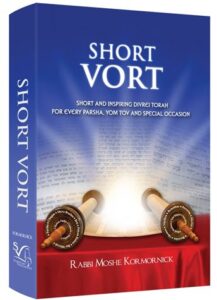The Mishna in Megilla tells us that on the Shabbos closest to Rosh Chodesh Nissan, we read the section in the Torah that begins with the first Mitzvah – that of sanctifying the New moon.[1] The most straightforward reason why we read it shortly before Pesach is because it contains the section about the korban Pesach.[2] However, the commentaries write that there are a number of other important points that are brought out from this section that relate to Pesach.
Parashas Hachodesh begins, ““This month shall be for you the first of the months, it is the first for you, of the months of the year.”[3] The Ramban writes that the Torah is instructing us to count the year beginning from this point in time, which was the beginning of the yetsias Mitzrayim. Accordingly, every month’s number will be in comparison to this time. For example, the second month will be viewed as the second month from the date of our redemption, and the third will be the third from the redemption, and so on.[4] By doing this, we will constantly be reminded of the first month and the miracles that took place on that date.
The Ramban says that this is similar to how we begin the counting of the week from Shabbos. Each day, when we say the chapter of Tehillim that corresponds to its day, we acknowledge the number of this day since Shabbos. For example, on Sunday we say “this is the first day of the week”, meaning that this is the first day since Shabbos. In this way we constantly remind ourselves of Shabbos. This is so important because Shabbos is a sign of Creation, in that HaShem created the world for six days and then rested on the seventh. By constantly acknowledging Shabbos, a person demonstrates that he believes that HaShem created the world.
Given the Ramban’s point about the importance of remembering both Shabbos and yetsias Mitzrayim, a question arises. Why is it insufficient to merely remember Shabbos, what is the necessity of also focusing so much on yetsias Mitzrayim? Indeed, Shabbos reminds us of the act of Creating the whole universe, that is a far greater miracle than all the miracles involved in yetsias Mitzrayim?
A similar question is asked with regard to the Ten Commandments, and the answers given there can also be used to answer this question. The first Mitzvah in the Ten Commandments is the Mitzvah of Emuna, believing in HaShem. The Torah says, “I am the Lord, your G-d, who took you out of the land of Mitzrayim from a house of slavery.”[5] The Torah does not suffice in saying, “I am the Lord, your G-d”, rather it adds a specific act that HaShem performed, that of taking the Jewish people out of Mitzrayim. The question is asked, that once the Torah is mentioning an act of HaShem, why did it not mention the fact that He created the world.
One of the answers is that yetsias Mitzrayim teaches us a certain additional aspect about HaShem we must believe in as part of the Mitzvah of Emuna. Creation shows that HaShem created the world, but it does not demonstrate that He remained involved in the world after He created it. One may claim that even though He did create the world, after that, He refrained from any further involvement and left the world to its own devices. However, yetsias Mitzrayim does indeed demonstrate that HaShem continues to be intimately involved in the world. This is the idea of Divine Providence, whereby HaShem maintains a constant interest and involvement in the world. Accordingly, when instructing us to believe in HaShem, the Torah chose to associate this with the fact that He took us out of Mitzrayim to teach us that it is not enough to merely believe that HaShem exists, and that he created the world. One must also acknowledge that He is constantly involved in the world.
With this explanation, we can also understand why yetsias Mitzrayim is so important that we start counting the months from the date when it began. Counting the days from Shabbos reminds us of the act of Creation, however counting the months from Nissan, reminds us of Divine Providence.
One still may ask, why is it so necessary to constantly remind a believing Jew that HaShem took us his nation out of Mitzrayim – he already believes it, so how do the constant reminders help? The answer is that is very easy to intellectually know something, but to internalize it is a far more difficult prospect. Rav Yisrael Salanter zt”l, the initiator of the study of mussar, taught that one of the most effective ways of internalizing a concept is by constantly repeating it, contemplating its meaning whilst doing so. It seems that the Torah prescribed numerous reminders of yetsias Mitzrayim to ensure that we remain constantly aware of it, and its ramifications.
May we all merit to internalize the lessons of Parshas HaChodesh and see the Hand of HaShem in our lives.

SHORT VORT, Rabbi Moshe Kormornick. Published by Adir Press. $9.99 in stores worldwide and online here
Whether you are looking for something meaningful on the Parsha, an uplifting thought for Yom Tov, or have been asked to speak at a Simcha – “Short Vort” is the book for you! With over 140 incredible short vorts packed with stories and valuable life messages, you will never be lost for something inspiring to say.
Rabbi Moshe Kormornick is a popular writer whose words are enjoyed by thousands of readers every week.










